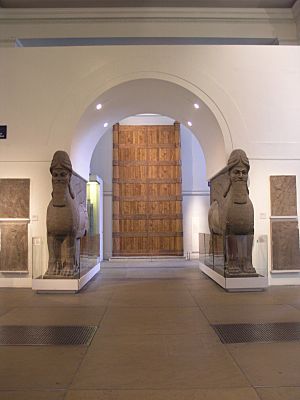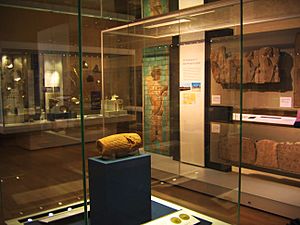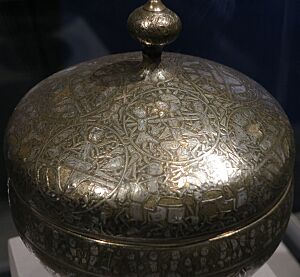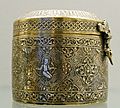British Museum Department of the Middle East facts for kids
The Department of the Middle East at the British Museum is like a giant treasure chest filled with amazing objects from ancient times. It holds about 330,000 items! This makes it one of the biggest collections of ancient objects from the Middle East outside of Iraq.
This special collection shows us the history of ancient civilizations from places like Mesopotamia (which is mostly modern-day Iraq), Persia, the Arabian Peninsula, Anatolia (modern-day Turkey), and parts of Syria and the Holy Land. The objects range from prehistoric times all the way up to the beginning of Islam in the 600s AD. The museum has some of the best collections of Assyrian, Babylonian, and Sumerian artifacts in the world. You can even see entire rooms decorated with huge stone carvings called bas-reliefs from ancient Assyrian palaces!
How the Collection Grew
The first important objects from Mesopotamia joined the museum in 1825, from a collection owned by Claudius James Rich. But the collection really grew thanks to the exciting discoveries made by A. H. Layard. He dug at ancient Assyrian sites like Nimrud and Nineveh between 1845 and 1851.

At Nimrud, Layard found the North-West Palace of King Ashurnasirpal II, along with other palaces and temples. Later, he uncovered the Palace of King Sennacherib at Nineveh, which had many rooms! Because of his work, many huge statues called Lamassu (human-headed winged creatures), carved wall panels (bas-reliefs), and stone slabs (stelae) were brought to the British Museum. One famous item is the Black Obelisk of King Shalmaneser III.
Layard's assistant, Hormuzd Rassam, continued the work. Between 1852 and 1854, he found the North Palace of King Ashurbanipal at Nineveh. Here, he discovered amazing carvings, including the famous Royal Lion Hunt scenes. He also found the Royal Library of Ashurbanipal, which was a huge collection of clay tablets with ancient writing called cuneiform. Today, there are about 130,000 of these important tablets!

Another archaeologist, W. K. Loftus, dug at Nimrud between 1850 and 1855. He found a remarkable collection of ivory carvings in a palace that had been burned. Rassam also added many beautiful objects to the museum between 1878 and 1882. These included the Cyrus Cylinder from Babylon, bronze gates from Balawat, and important items from Sippar.
In the early 1900s, more excavations happened. After the First World War, many more Mesopotamian objects came to the museum from southern Iraq. From a place called Tell al-Ubaid, bronze decorations from a Sumerian temple were found, including life-sized lions.
Leonard Woolley excavated the ancient city of Ur between 1922 and 1934. He discovered the 'Royal Cemeteries' from about 4,500 years ago! Some of the most famous items he found include the 'Standard of Ur', the 'Ram in a Thicket', the 'Royal Game of Ur' (an ancient board game), and two lyres (musical instruments) with bull heads. The department also has statues of a ruler named Gudea from the ancient state of Lagash.
Even though the collection focuses on Mesopotamia, many surrounding areas are also well represented. The collection from the Achaemenid Persian Empire grew with the addition of the Oxus Treasure in 1897. This treasure is the largest collection of ancient Persian gold objects. The museum also has a great collection of silver items from the later Sasanian Empire.
Objects from Phoenicia (an ancient civilization known for trade) come from different places, including a special collection from Tharros in Sardinia. The museum also has a wonderful collection of ancient objects from Yemen, which is the best outside of Yemen itself.
From modern-day Syria, there are almost forty carved faces from Palmyra and stone carvings from Tell Halaf. More items came from digs by Max Mallowan (whose wife was the famous writer Agatha Christie) at places like Chagar Bazar and Tell Brak. The collection of objects from Palestine was also made stronger by the work of Kathleen Kenyon at Jericho in the 1950s. Today, archaeological digs still happen in the Middle East, and the museum sometimes receives a share of the new finds.
What You Can See
The museum's collection of Islamic art has about 40,000 objects, making it one of the largest in the world. It includes many types of pottery, paintings, tiles, metalwork, glass, and seals from across the Islamic world, from Spain to India. It's especially famous for its collection of Iznik ceramics, which are beautiful tiles and dishes. A highlight is a mosque lamp from the Dome of the Rock. There's also medieval metalwork like the Vaso Vescovali, which shows signs of the Zodiac, and beautiful Mughal paintings from India.
About 4,500 objects from the Department of the Middle East are on display in 13 galleries throughout the museum. On the ground floor, you can see huge carved reliefs from the Assyrian palaces. On the upper floor, eight galleries hold smaller items from ancient sites across the Middle East. The rest of the collection, which includes about 130,000 cuneiform tablets, is used for study.
Key Highlights of the Collections
Here are some of the most important and interesting items you can find:
|
Carved Wall Panels (Bas-reliefs) from:
|
Sculptures:
|
|
Carved Wall Panels (Bas-reliefs) and Sculptures from:
|
Royal Library of King Ashurbanipal:
|
|
|
|
Gallery
-
Room 56 – The 'Ram in a Thicket' figure from Ur, Southern Iraq, c. 2600 BC
-
Room 56 – The famous 'Standard of Ur', a hollow wooden box with scenes of war and peace, from Ur, c. 2600 BC
-
Room 6 – A depiction of Jehu, King of Israel, on the Black Obelisk of Shalmaneser III, Nimrud, c. 827 BC
-
Room 10 – Human-headed winged bulls from Khorsabad, Iraq, 710-705 BC
-
Room 55 – Cuneiform Collection, including the Epic of Gilgamesh, Iraq, c. 669-631 BC
-
Room 55 – The Dying Lion, Nineveh, Neo-Assyrian, Iraq, c. 645 BC
-
Room 55 - Panel with a striding lion made from glazed bricks, Neo-Babylonian, from the time of Nebuchadnezzar II, Southern Iraq, 604-562 BC
-
Room 52 – A chariot from the Oxus Treasure, a collection of Achaemenid Persian metalwork, c. 5th to 4th centuries BC
-
Room 53 - Stela from Tamma' cemetery, Yemen, 1st century AD
-
Room 53 - Alabaster statue of a standing female figure, Yemen, 1st-2nd centuries AD
















